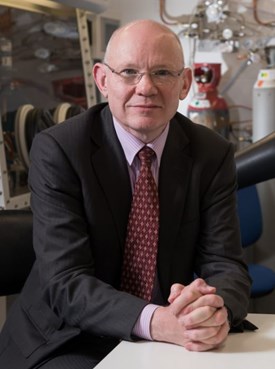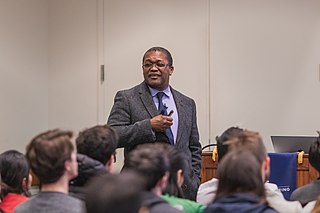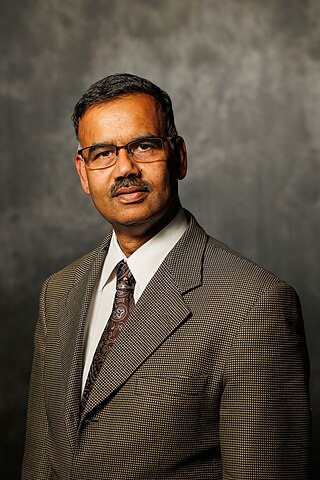
John Bannister Goodenough was an American materials scientist, a solid-state physicist, and a Nobel laureate in chemistry. From 1996 he was a professor of Mechanical, Materials Science, and Electrical Engineering at the University of Texas at Austin. He is credited with identifying the Goodenough–Kanamori rules of the sign of the magnetic superexchange in materials, with developing materials for computer random-access memory and with inventing cathode materials for lithium-ion batteries.

Michael Stanley Whittingham is a British-American chemist. He is a professor of chemistry and director of both the Institute for Materials Research and the Materials Science and Engineering program at Binghamton University, State University of New York. He also serves as director of the Northeastern Center for Chemical Energy Storage (NECCES) of the U.S. Department of Energy at Binghamton. He was awarded the Nobel Prize in Chemistry in 2019 alongside Akira Yoshino and John B. Goodenough.
Sossina M. Haile is an American chemist, known for developing the first solid acid fuel cells. She is a professor of materials science and engineering at Northwestern University, Illinois, US.
A potassium-ion battery or K-ion battery is a type of battery and analogue to lithium-ion batteries, using potassium ions for charge transfer instead of lithium ions. It was invented by the Iranian/American chemist Ali Eftekhari in 2004.

Akira Yoshino is a Japanese chemist. He is a fellow of Asahi Kasei Corporation and a professor at Meijo University in Nagoya. He created the first safe, production-viable lithium-ion battery, which became used widely in cellular phones and notebook computers. Yoshino was awarded the Nobel Prize in Chemistry in 2019 alongside M. Stanley Whittingham and John B. Goodenough.

Sir Peter George Bruce, is a British chemist, and Wolfson Professor of Materials in the Department of Materials at the University of Oxford. In 2018, he was appointed as Physical Secretary and Vice President of the Royal Society. Bruce is a founder and Chief Scientist of the Faraday Institution.

Jean-Marie Tarascon FRSC is Professor of Chemistry at the Collège de France in Paris and Director of the French Research Network on Electrochemical Energy Storage (RS2E).

Kuzhikalail M. Abraham is an American scientist, a recognized expert on lithium-ion and lithium-ion polymer batteries and is the inventor of the ultrahigh energy density lithium–air battery. Abraham is the principal of E-KEM Sciences in Needham, Massachusetts and a professor at the Northeastern University Center for Renewable Energy Technologies, Northeastern University, in Boston, Massachusetts.

Maria Helena Sousa Soares de Oliveira Braga is an associate professor at the Engineering Physics Department of University of Porto, Portugal. She is currently focused on research areas in Materials Science and Materials Engineering at University of Porto and University of Texas at Austin. She is credited with expanding the understanding of glass electrolyte and glass batteries with colleague John B. Goodenough. Braga is a senior research fellow in the Materials Institute headed by Goodenough.
Martin Winter is a German chemist and materials scientist. His research in the field of electrochemical energy storage and conversion focuses on the development of new materials, components and cell designs for batteries and supercapacitors, lithium ion batteries and lithium metal batteries.
Linda Faye Nazar is a Senior Canada Research Chair in Solid State Materials and Distinguished Research Professor of Chemistry at the University of Waterloo. She develops materials for electrochemical energy storage and conversion. Nazar demonstrated that interwoven composites could be used to improve the energy density of lithium–sulphur batteries. She was awarded the 2019 Chemical Institute of Canada Medal.

Jennifer L. M. Rupp FRSC is a material scientist and professor at the Technical University of Munich, visiting professor at the Massachusetts Institute of Technology and the CTO for battery research at TUM International Energy Research. Rupp has published more than 115 papers in peer reviewed journals, co-authored 7 book chapters and holds more than 25 patents. Rupp research broadly encompasses solid state materials and cell designs for sustainable batteries, energy conversion and neuromorphic memory and computing.

Yi Cui is a Chinese-American materials scientist, specializing in nanotechnology, and energy and environment-related research. Cui is the Fortinet Founders Professor of Materials Science and Engineering, and by courtesy, of Chemistry at Stanford University. He currently serves as the director of the Precourt Institute for Energy, succeeding Arun Majumdar and Sally Benson. He has been named the inaugural faculty director of the Sustainability Accelerator within the Stanford Doerr School of Sustainability. He also serves as a co-director of the Bay Area Photovoltaics Consortium, the Battery500 Consortium, and the StorageX initiative. He is a faculty member of Stanford Photon Science of SLAC, principal investigator at the Stanford Institute for Materials & Energy Sciences, and a senior fellow at Stanford Woods Institute for the Environment. He is an elected member of the National Academy of Sciences, and Fellow of the American Association for the Advancement of Science (AAAS), Materials Research Society (MRS), Electrochemical Society (ECS), and the Royal Society of Chemistry (RSC). He has been one of the world's most-cited researchers and most influential scientific minds. He has published over 560 research papers with an H-index of 261. He currently serves as the Executive Editor of Nano Letters from ACS Publications.

Ying Shirley Meng is a Singaporean-American materials scientist and academic. She is a professor at the Pritzker School of Molecular Engineering at the University of Chicago and Argonne Collaborative Center for Energy Storage Science (ACCESS) chief scientist at Argonne National Laboratory. Meng is the author and co-author of more than 200 peer-reviewed journal articles, two book chapter and six patents. She serves on the executive committee for battery division at the Electrochemical Society and she is the Editor-in-Chief for MRS Energy & Sustainability.
Khalil Amine is a materials scientist at Argonne National Laboratory, an Argonne distinguished fellow, and group leader of the Battery Technology group. His research team is focused on the development of advanced battery systems for transportation applications. In addition to his Argonne appointment, he is an adjunct professor at Stanford University, Imam Abdulrahman Bin Faisal University, Hong Kong University of Science & Technology, King Abdulaziz University, Hanyang University, and Peking University.

Lynden A. Archer is a chemical engineer, Joseph Silbert Dean of Engineering, David Croll Director of the Energy Systems Institute, and professor of chemical engineering at Cornell University. He became a fellow of the American Physical Society in 2007 and was elected into the National Academy of Engineering in 2018. Archer's research covers polymer and hybrid materials and finds applications in energy storage technologies. His h-index is 92 by Google Scholar.
Michel Armand is a French scientist who is best known for introducing the concept of a rocking-chair battery in 1978. In rocking-chair battery the same type of ion is de/intercalated into both positive and negative electrode during dis/charge. As a result, solution-phase species do not appear in the reaction stoichiometry, which allows for minizing the amount of solvent in the battery, reduces the battery weight and cost.

This is a history of the lithium-ion battery.
Karim Zaghib is an Algerian-Canadian electrochemist and materials scientist known for his contributions to the field of energy storage and conversion. He is currently Professor of Chemical and Materials Engineering at Concordia University. As former director of research at Hydro-Québec, he helped to make it the world’s first company to use lithium iron phosphate in cathodes, and to develop natural graphite and nanotitanate anodes.

Venkataraman Thangadurai PhD, FRSC (UK), FECS, FRSC is a scientist and researcher known for his contributions to the field of solid state ionics and solid-state chemistry. He is a Professor and Research Excellence Chair at the University of Calgary in the Department of Chemistry. He’s also the Founder and director of Western Canada Battery Consortium (WCBC) and Associate Director of Calgary Advanced Energy Storage and Conversion Research (CAESR). He acts as the Vice-Chair of the Canada Section Electrochemical Society (ECS) and Associate Editor of ACS Applied Materials and Interfaces. He is a fellow of The Electrochemical Society (USA), Royal Society of Chemistry (UK), and Royal Society of Canada and in the Editorial Advisory Board Journal of Solid State Electrochemistry, Chemistry of Materials, Energy Technology, Journal of Materials Chemistry A, Materials Advances, and International Journal of Ionics. Thangadurai’s over 30 years of experience in solid-state chemistry is showcased by his over 250 international publications and 13 patent applications.












